Beth Gill and New York Live Arts and Lance Gries at Danspace St. Marks make a virtue of economy.
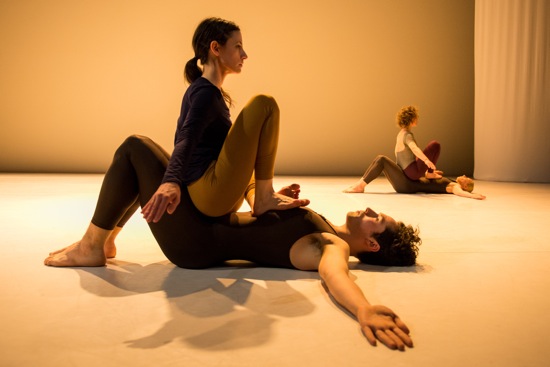
Beth Gill’s New Work for the Desert. Foreground: Jennifer Lafferty and Stuart Singer. At back: Marilyn Maywald on Heather Lang. Photo: Cherylynn Tsushima
In the deserts of the American Southwest, everything counts: the immense sky, that butte over there, those spiky plants, the track in the red earth (lizard? Maybe). Beth Gill’s beautiful New Work for the Desert has that kind of clarity. Watching it, you sense open space and the trails that cross it; you think of an animal, still as a rock, sniffing the wind. Much of the time, the dancers move slowly, deliberately, making a pose travel across the stage of New York Live Arts, where the work had its premiere. But that calm may also be broken by a brief bustle of movement.
Jon Moniaci’s music and Thomas Dunn’s set and lighting design abet Gill’s spare choreography. The performing area is essentially gray—the floor and the three tall, fat, curved partial pillars that flank the space on either side—but when you first see this onstage world, it’s dimly lit, blue, and silent. As the piece progresses, the lights shade downward or brighten; the backcloth—and occasionally the floor— may turn golden, dawn peach, cerise, lavender, deep red, and almost white, with a whiter hazy sun in the middle of it. At first these changes in the lighting happen gradually; toward the end of New Work for the Desert, they put on their own show. Moniaci sits silently by his piano and laptop for quite a while before introducing what sounds like a distant ticking. Sometimes he produces a single note, a small melody, a chord that hangs in the air, as well as sounds that suggest a terrain.
New Work for the Desert is not very long—an hour or less; in any case, because it has such clarity and such economy, you relinquish your sense of time passing and any desire you might have for high-contrast variety. Jennifer Lafferty is the first person onstage. At first she’s only a dark figure against the blueness, walking slowly across the stage. What’s remarkable is that she holds her curved arms behind her in a way that looks uncomfortable and oddly birdlike. She gazes down at the floor in front of her. Her rhythm is steady, but if you watch carefully, you may catch a small hesitation or two. And you do watch—intently—until she reaches the opposite side of the stage and disappears.
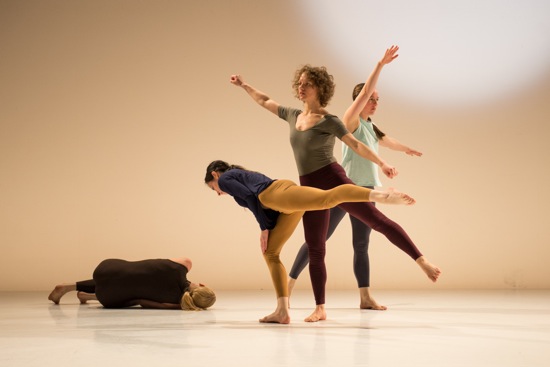
(L to R): Heather Lang, Jennifer Lafferty, Marilyn Maywald, and Christiana Axelsen in Beth Gill’s New Work for the Desert. Photo: Cherylynn Tsushima
The light is brightening. When Marilyn Maywald enters, she casts a shadow. Slowly, slowly, she shows you other possibilities. She opens her arms wide, squats, and tilts to one side like a glider banking. Curving an arm has the force of a major statement. She makes a few other moves, one of which involves balancing on one leg with the other bent in front of her. Many minutes later, someone else will echo that.
As incidents accumulate, something nudges into my memory. I’m aware of two strains of movement. One is blocky, set; the dancers (there are six in all) look unbudgeable, printed on the space. The other is springy, a bit looser, coming as sudden eruptions; people occasionally glance off one another or nearly collide, and you may think you’ve seen a mistake, but you haven’t. Later that night, I read an interview with Gill by Gia Kourlas (http://www.timeout.com/newyork/dance/beth-gill-2) and discover that the work of light artist James Turrell gave the Gill ideas about her own piece and that her memories of a dance that she loved, Trisha Brown’s 1987 Newark (Niweweorce), impelled her choreography enough to give it the lineaments of an homage.
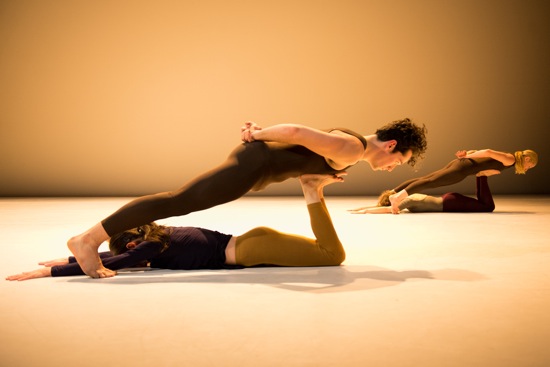
Foreground: Stuart Singer on Jennifer Lafferty. At back: Heather Lang on Marilyn Maywald. Photo: Cherylynn Tsushima
Newark, part of what Brown categorized as her “Valiant” series, was the first piece in which she created a distinctive kind of movement for the men that differed from that for the women. In perfect unison, Lance Gries and Jeffrey Axelrod went through a litany of big clear movements in place, while the four women occasionally passed through in flurries of looser, twistier, more buoyant steps before joining them. In New Work for the Desert, Heather Lang and Stuart Singer take on the job of acting in perfect synchrony, making clean-edged sculptures with their bodies. When tall Lang first enters, she strikes out, in profile, into a deep lunge and holds it a few seconds before continuing on with another and another. You think of that lunge as iconic; it’s stamped on your retina. So is the repeated image of a dancer dropping to the floor and rolling back onto her shoulders to aim her legs (carefully positioned) skyward.
For much of the piece, Lafferty is a kind of monitoring force, holding down center stage, but she and Maywald join Lang and Singer to form two couples, who—just as in Newark—create a string of identical joint images. Lafferty with Singer and Maywald with Lang. These poses, each merging smoothly into the next one, have the look of imaginative architecture, built with an eye to balance, counterbalance, and interlocking parts.
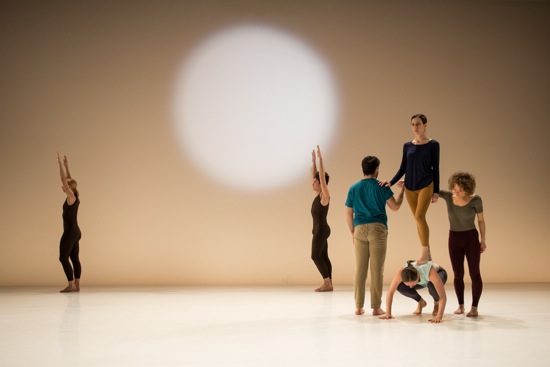
Jennifer Lafferty stands on Christiana Axelsen. Kayvon Pourazar and Marilyn Maywald assist. At back: Heather Lang and Stuart Singer. Photo: Cherylynn Tsushima
But New Work for the Desert is also pitted with surprises. Singer and Lang on the floor, propelling themselves forward with their arms, their legs dragging behind them like lizards’ tails, their gazes turning skyward. Lang upending herself against Maywald’s leg. Lafferty standing on Axelsen to survey something distant, while Maywald and Kayvon Pourazar flank and support her.
Too, despite the unison, Gill wants us to see the dancers as individuals, and Pourazar, who enters last, asserts himself with wide-legged, thumping steps. He also performs a curving, resilient, three-dimensional solo, in contrast to the ongoing two-dimensional labors of Lang and Singer, who remain straight or angled. Pourazar and Axelsen don’t dance alike, but they dance together with a certain tenderness. At the end of the piece, they stand facing each other, and one of them carefully, gravely strokes the other’s face. If there’s a rustle of quick, springy movement near the stage-left wings, chances are these two are involved in it. Maywald too. I see her as kind of a loose canon. Certainly no one else vaults onto the stage the way she does, with a startling, one-time-only leap.
Gill’s piece is elegantly engineered; the speed with which changes occur accelerates slightly toward the end, quickening the spectator’s pulse despite the over-riding calm. It’s difficult to convey in words how Gill’s work is both crystalline and earthy, spare, yet complex. She and her splendid collaborating dancers, designer, and composer paint a landscape of barely changing activities and sudden eruptions. At some point, a hiss emanates from Moniaci’s sound score and disappears. Just so do brief, one-time events crop up in the choreography. I come to think of the work in terms of the interplay between what is apparently constant or inevitable and what is unexpected: a bird suddenly flutters onto a weathered branch as the sun begins to burn hotly down.
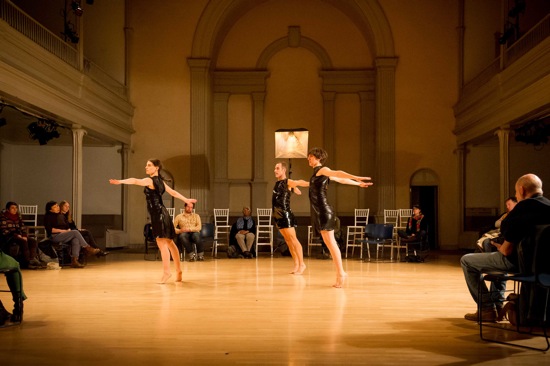
Lance Gries’s IF Immanent Field (dress rehearsal). (L to R): Jimena Paz, Lance Gries, and Juliette Mapp. Photo: Ian Gibson
From 1985 to 1991 Lance Gries brought to the Trisha Brown Company the strength, fluidity, intelligence, and wiliness that Brown’s choreography requires. He has been busy since as a teacher and choreographer, both in the U.S. and abroad. I unfortunately missed his solo Études for an Astronaut, which was nominated for a Bessie in 2011. IF Immanent Field is the first work of his that I’ve seen in years.
The performance presented by Danspace at St. Mark’s Church begins 15 minutes before it begins, although not every ticket holder knows that. The usual gray chairs, alternating with high-backed white ones are arranged in a circle, with gaps at each corner for entrances and exits. In addition to the usual lighting, Carol Mullins has positioned three tall photo-studio lamps, with umbrella-like, reflecting hoods. Intermittently Gries, Jimena Paz, and Juliette Mapp test out their movements. They also function as hosts—smiling at various spectators, leaning over to speak with others or grasp their hands. Gries kneels before a few people. The performers wear various items of clothing over what may turn out to be their costumes, e.g. a short transparent, salmon pink kimono for Mapp. Diane Madden—the co-associate artistic director of the Trisha Brown company and a colleague of Gries’s from their dancing days with Brown—is less visible at first; she stumps in wearing after-ski boots and a lot of clothing to check the space just before the piece proper begins.
Afterward, I’m not sure of Gries’s reason for that pre-performance. It introduces us to the dancers of IF Immanent Field and shows us in an engaging informal way what they will be doing for the performance itself. And you can still read your program and talk to your neighbor, while audience members straggle in. Still, it adds to the length of the evening, and I glances at my watch at a certain point (something I rarely do) and find that I have already been watching for an hour events that aren’t scheduled to end for another half hour.
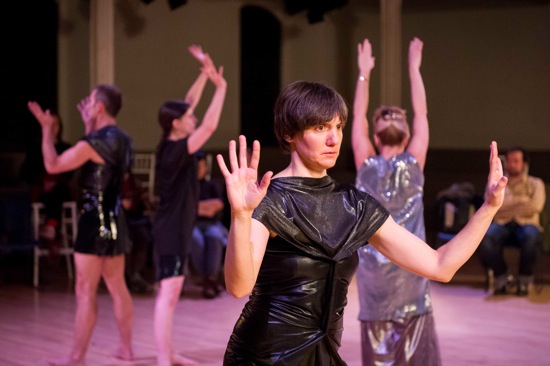
Foreground: Juliette Mapp. At back (L to R): Lance Gries, Jimena Paz, and Diane Madden in IF Immanent Field. Photo: Ian Douglas
I wonder which meaning of “immanent” Gries wants us to understand. That this field (perhaps he has been reading Gilles Deleuze’s Pure Immanence ) is immanent in all the performers, shared by them? That it is essential, intrinsic to something larger than just their lives? Much of what they do is what we all do: walk. They are, however, always sculpting the air with gestures that look significant and familiar—most of them performed symmetrically with both arms. They may seem to push something away, to offer an invisible gift, to form wings, to carry an object, to push aside a curtain. They spread their bent arms out to either side, palms up, as if readying their hands to act as scales; bring them fleetingly together in a way that signals prayer; place one hand on their chests and one on their bellies. Walking or planting their feet, bending deeply to enlarge the flow of gestures, they are wonderfully intent, gazing upward or into some space beyond us or at us. These are very fine performers. Gries’s movements are especially weighted; often with bent knees bent and feet turned out like a Balinese dancer’s, he seems to be leaning and turning to accommodate features of a landscape we can’t see. At one point, I imagine him stooping to enter a cave.
Each performer seems to assemble the vocabulary in an individual way. And they come and go, as if at will, gradually divesting themselves of their outer garments. They never touch, although occasionally their paths come close to colliding. Intermittently, they smile. Watching them is like seeing an alien cosmology going through its orbits in changing light and accompanied by sounds as calming as high, singing voices and ominous as deep rumbles (the atmospheric score was composed and executed by Ryan Seaton).
Some way into the piece, Madden enters and walks to the center of the space; for her, the lights dim, and Seaton quietens the music. She wears a very long, gleaming silver sheath; it’s so shiny that you can almost see reflections in it. Very slowly she begins to rotate, she, too, tracing gestures on the air. The other three dancers begin to circle her, turning and bending as they travel. A low melody starts up, and their tempo increases slightly. Are their orbits bringing them closer to Madden? When, for the first time, they briefly form a diagonal, it seems like a sign of things to come.
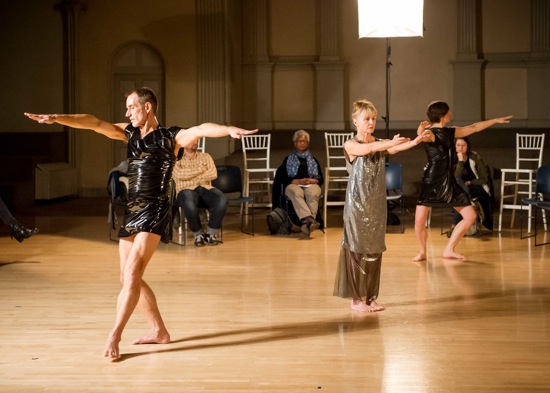
Dress rehearsal for IF Immanent Field. (L to R): Lance Gries, Diane Madden, and Juliette Mapp. Photo: Ian Douglas
By now all three are bare-legged, wearing black trunks and interestingly cut and stitched black vinyl tops (Liz Prince is credited with costume consultation and execution). Eventually, they find a common rhythm. It’s a shock when they all strike out together in a deep lunge to the east. Mullins lays a circle of light around Madden, but that presages her departure. Now the other three enlarge their movements, drop to the floor, sit up and gaze skyward, lie down again. Aided by a tolling in Seaton’s score, they finally fall into unison. But Gries is not ready for simple answers. A man gets up from the audience (it is ex-Brown dancer David Thomson), offers his own solo take on what they’ve been doing and sits back down. A few minutes later, while the three go from increased speed to slow motion, another rogue male, skinny and dressed for the outdoors, puts his skateboard down in an aisle and, for several seconds, does his response to the evening’s dancing (this is, I believe, Harry Moritz).
The audience’s response is to applaud with fervor. IF Immanent Field is a curious and intriguing adventure. Operating according to a system you sense but may not be able to fathom, it’s deliberately limited in terms of movement, yet expansive in its implications. Just as it begins to test your patience, it startles you again.
